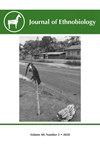摘还是不摘:摄影凭证标本作为民族植物学中植物采集的一种替代方法
IF 1.3
3区 社会学
Q1 ANTHROPOLOGY
引用次数: 1
摘要
根据林奈分类系统对植物进行鉴定是民族植物学的基石,使该学科成为一门比较科学。为了完成植物鉴定,民族植物学家长期依赖于收集代金券标本及其在植物标本室的沉积。在这里,我们批判性地分析了植物收集在民族植物学中的作用,并关注了一系列可能使实践复杂化,有时甚至阻碍实践的问题。代替传统的植物标本馆标本,摄影凭证的收集和它们在数字存储库中的沉积被提议作为民族植物学研究的另一种方法。不断提高的质量和无处不在的智能手机相机,像Pl@ntnet和iNaturalist这样的摄影公民科学应用程序,以及自动照片识别的深度学习技术,作为促成数字数据在科学领域的缓慢革命的因素进行了讨论。关于植物标本馆标本与摄影凭证何时被认为是必需的指南已被列出。虽然植物收集毫无疑问将有充分的理由仍然是民族植物学的基础实践,但我们提出使用照片凭证作为一种有效的,科学严谨的,在某些情况下,首选的识别方法。本文章由计算机程序翻译,如有差异,请以英文原文为准。
To Pick or Not to Pick: Photographic Voucher Specimens as an Alternative Method to Botanical Collecting in Ethnobotany
The identification of plants according to the Linnaean system of taxonomy is a cornerstone of ethnobotany, allowing the discipline to be a comparative science. To accomplish plant identification, ethnobotanists have long relied on the collection of voucher specimens and their deposition in herbaria. Here we critically analyze the role of botanical collecting in ethnobotany and bring attention to a range of issues that can complicate, and sometimes hamper, the practice. In lieu of traditional herbarium specimens, the collection of photographic vouchers and their deposition in digital repositories is proposed as an alternative method for ethnobotanical research. The ever-improving quality and ubiquity of smartphone cameras, photographic citizen science applications like Pl@ntnet and iNaturalist, and deep learning techniques of automated photo identification are discussed as elements that are contributing to a slow revolution in the role of digital data in the field sciences. Guidelines for when plant herbarium specimens versus photographic vouchers should be considered required are laid out. Although botanical collecting will doubtless and with good reason remain a foundational practice in ethnobotany, we present the use of photographic vouchers as a valid, scientifically rigorous and, in some situations, preferred method of identification.
求助全文
通过发布文献求助,成功后即可免费获取论文全文。
去求助
来源期刊

Journal of Ethnobiology
Social Sciences-Anthropology
CiteScore
4.80
自引率
3.40%
发文量
21
审稿时长
>12 weeks
期刊介绍:
JoE’s readership is as wide and diverse as ethnobiology itself, with readers spanning from both the natural and social sciences. Not surprisingly, a glance at the papers published in the Journal reveals the depth and breadth of topics, extending from studies in archaeology and the origins of agriculture, to folk classification systems, to food composition, plants, birds, mammals, fungi and everything in between.
Research areas published in JoE include but are not limited to neo- and paleo-ethnobiology, zooarchaeology, ethnobotany, ethnozoology, ethnopharmacology, ethnoecology, linguistic ethnobiology, human paleoecology, and many other related fields of study within anthropology and biology, such as taxonomy, conservation biology, ethnography, political ecology, and cognitive and cultural anthropology.
JoE does not limit itself to a single perspective, approach or discipline, but seeks to represent the full spectrum and wide diversity of the field of ethnobiology, including cognitive, symbolic, linguistic, ecological, and economic aspects of human interactions with our living world. Articles that significantly advance ethnobiological theory and/or methodology are particularly welcome, as well as studies bridging across disciplines and knowledge systems. JoE does not publish uncontextualized data such as species lists; appropriate submissions must elaborate on the ethnobiological context of findings.
 求助内容:
求助内容: 应助结果提醒方式:
应助结果提醒方式:


